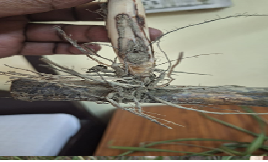White Grub
White Grub
Damage Symptoms
• Grubs feed on main roots of sugarcane and damage the underground portions of stalks.
• Due to feeding, leaves can turn yellow and such clumps gradually dry up and easily pulled out.
• Affected canes collapse, dry up and become unfit for crushing or planting.
• The damage generally occurs in patches.
• During April-May, the peak infestation is observed in August.
• The pest overwinters in adult and grub stages in earthen cells from October to February.
• Pupation occurs in March and adult emergence takes place in the April-June.
Management
• The mass emergence of beetles after the fast heavy summer shower easy for their large scale hand collection of insect.
• During the peak period of adult emergence light trap may be use for collections of adult.
• Heavily infested fields may be ploughed with tractor and the grubs, pupae and beetles hand-picked and destroyed.
• Repeated ploughing reduces the grubs’ populations.
• Altering the time of planting.
• Paddling and crop rotation should be done with paddy.
• Frequent hoeing and stirring up of soil near the base of tender shoots reduce attack
• Ploughing and flooding in February when planting is taken up during the pest activity period would be useful in minimizing grub populations.
• Beauveria brongnianii formulated with carrier materials such as press mud, lignite or talc may be applied at 2.5 x 10'' spores / ha during June-July.
• The formulation may be mixed with suitable quantity of farm yard manure or well cured press mud and distributed in the harrows followed by irrigation.
• Apply Thiamethoxam 00.90 % + Fipronil 00.20 % GR @15kg ha or Fipronil 40 % + Imidacloprid 40 % WG @500gm/ha.



